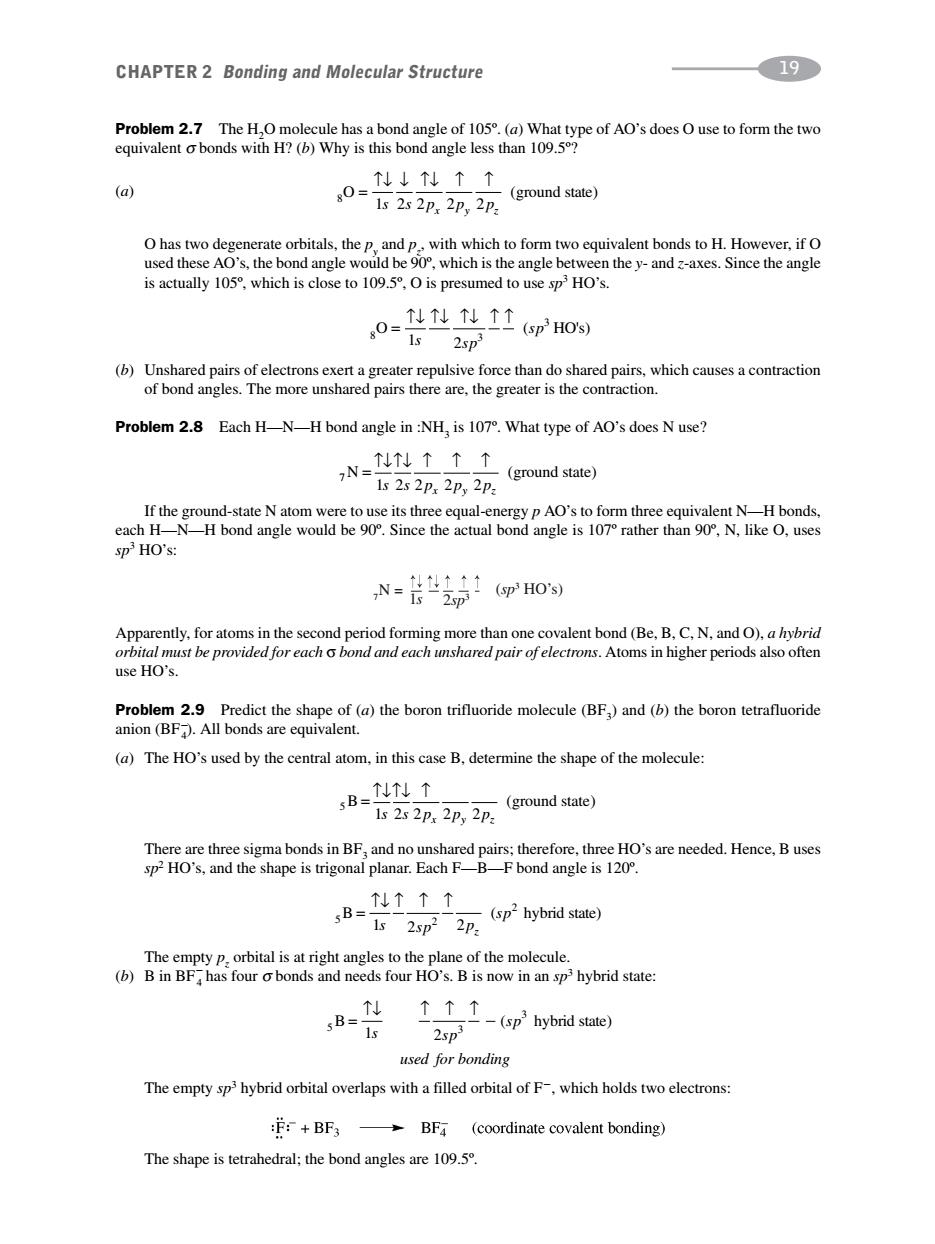正在加载图片...

CHAPTER 2 Bonding and Molecular Structure 19 equnaeaatanwiHpbiwiyishsbndgels@l0gPeofAosdoesoueofomtem Problem 2.7 The H,O molecule has a bond angle of 105.(a)What (a) ↑U↓↑↑ o has two degenerate orbitals the p and p with which to form two equivalent bonds to h However if o used these AO's.the bond angle would bewhich is the angle between theyand zaxes.Since the angle is actually 105.which is close to 109.5is presumed to use spHO's. LLL↑1p09 g0= 1s 2sp (b)Unshared pairs of electrons exert a greater repulsive force than do shared pairs,which causes a contraction of bond angles.The more unshared pairs there are.the greater is the contraction. Problem 2.8 Each H-N-H bond angle in:NH,is 107.What type of AO's does N use? ,N=T1↑ 「1s2s2p.2p,2p -(ground state) angle SPHO's: Apparently.for atoms in the second period forming more than one covalent bond (Be.B.C.N.and O).a hybrid HobeoonddenNompenodo (a)The HO's used by the central atom.in this case B.determine the shape of the molecule: 58=L7 522n.242p(oae) .Henc,use s 2sp (sphybrid stae) s8、 2sp3 -(sp'hybrid state) used for bonding The empty sphybrid orbital overlaps with a filled orbital of F-which holds two electrons: :f:+BF3→BFa(coordinate covalent bonding) The shape is tetrahedral;the bond angles are 109.5Problem 2.7 The H2 O molecule has a bond angle of 105º. (a) What type of AO’s does O use to form the two equivalent σ bonds with H? (b) Why is this bond angle less than 109.5º? (a) O has two degenerate orbitals, the py and pz , with which to form two equivalent bonds to H. However, if O used these AO’s, the bond angle would be 90º, which is the angle between the y- and z-axes. Since the angle is actually 105º, which is close to 109.5º, O is presumed to use sp3 HO’s. 8 1 22 2 2 O = ground state ↑↓ ↓ ↑↓ ↑ ↑ ssp p p xyz ( ) CHAPTER 2 Bonding and Molecular Structure 19 8 3 3 1 2 O H = O's ↑↓ ↑↓ ↑↓ ↑ ↑ s sp ( ) sp (b) Unshared pairs of electrons exert a greater repulsive force than do shared pairs, which causes a contraction of bond angles. The more unshared pairs there are, the greater is the contraction. Problem 2.8 Each H—N—H bond angle in :NH3 is 107º. What type of AO’s does N use? 7 122 2 2 N = ground state ↑↓↑↓ ↑ ↑ ↑ ssp p p xyz ( ) If the ground-state N atom were to use its three equal-energy p AO’s to form three equivalent N—H bonds, each H—N—H bond angle would be 90º. Since the actual bond angle is 107º rather than 90º, N, like O, uses sp3 HO’s: 1s 7N = (sp3 HO’s) 2sp3 Apparently, for atoms in the second period forming more than one covalent bond (Be, B, C, N, and O), a hybrid orbital must be provided for each σ bond and each unshared pair of electrons. Atoms in higher periods also often use HO’s. Problem 2.9 Predict the shape of (a) the boron trifluoride molecule (BF3) and (b) the boron tetrafluoride anion (BF 4). All bonds are equivalent. (a) The HO’s used by the central atom, in this case B, determine the shape of the molecule: 5 122 2 2 B = ground state ↑↓↑↓ ↑ ssp p p xyz ( ) There are three sigma bonds in BF3 and no unshared pairs; therefore, three HO’s are needed. Hence, B uses sp2 HO’s, and the shape is trigonal planar. Each F—B—F bond angle is 120º. 5 2 2 1 2 2 B = hybrid state ↑↓ ↑ ↑ ↑ s sp p sp z ( ) 5 3 3 1 2 B = hybrid state ↑↓ ↑ ↑ ↑ s sp ( ) sp used for bonding The empty sp3 hybrid orbital overlaps with a filled orbital of F, which holds two electrons: The empty pz orbital is at right angles to the plane of the molecule. (b) B in BF 4 has four σ bonds and needs four HO’s. B is now in an sp3 hybrid state: The shape is tetrahedral; the bond angles are 109.5º.���